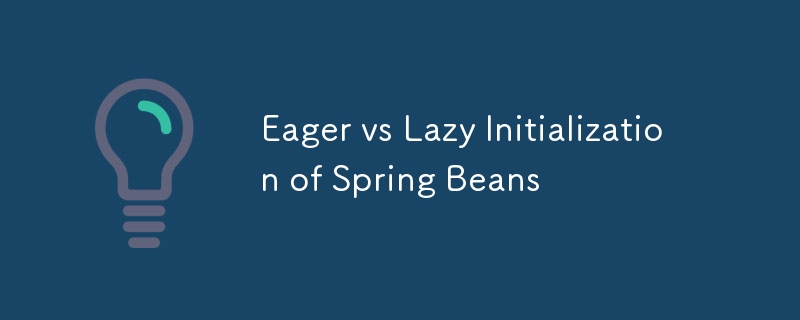
在 Spring 中,基本概念之一圍繞著 beans 的初始化。使用 Spring 框架開發應用程式時,您可以選擇 bean 的 eager 和 lazy 初始化。兩者都有其獨特的優勢和權衡,了解這些差異可以幫助您優化應用程式的效能和資源使用。
在深入探討急切初始化和惰性初始化之前,讓我們先簡單介紹一下 Spring bean 是什麼。在 Spring 中,bean 只是一個由 Spring IoC(控制反轉)容器實例化、組裝和管理的物件。預設情況下,Bean 通常是單例的(儘管可以更改),並且代表 Spring 應用程式的核心構建塊。
急切初始化是 Spring 中的預設行為。當Spring的ApplicationContext被創建時,它會急切地實例化配置中定義的所有bean。這意味著一旦 Spring 上下文完全加載,所有單例 bean 就會被創建並註入它們的依賴項。
考慮以下範例:
@Configuration
public class AppConfig {
@Bean
public ServiceA serviceA() {
return new ServiceA();
}
@Bean
public ServiceB serviceB() {
return new ServiceB();
}
}
在上面的程式碼中,一旦ApplicationContext初始化,ServiceA和ServiceB都會被實例化。這是熱切初始化的實際應用。
早期故障偵測:由於所有 bean 都是在啟動時實例化的,因此任何問題(例如設定錯誤、缺少依賴項或 bean 建立失敗)都會立即偵測到。這使得在開發過程中更容易識別和解決問題。
可預測的啟動行為:透過急切初始化,啟動過程是可預測的,因為所有 bean 都是提前創建的,確保它們在應用程式啟動後立即可供使用。
增加啟動時間:如果您的應用程式有許多Bean 和依賴項,急切初始化會增加應用程式的啟動時間,因為所有Bean 都會立即創建,無論它們是否立即需要.
記憶體使用:急切的初始化可能會導致更高的記憶體消耗,特別是對於不立即使用的bean。應用程式上下文初始化後,所有 Bean 都會佔用內存,這在某些情況下可能會造成浪費。
延遲初始化,顧名思義,推遲 Bean 的創建,直到應用程式首次請求它們。這意味著一個 bean 僅在被另一個 bean 或應用程式邏輯存取時才會被實例化。
在 Spring 中,可以透過使用 @Lazy 註解單一 bean 或為所有 bean 全域設定延遲初始化來啟用延遲初始化。
以下是實作延遲初始化的方法:
@Configuration
public class AppConfig {
@Bean
@Lazy
public ServiceA serviceA() {
return new ServiceA();
}
@Bean
public ServiceB serviceB() {
return new ServiceB();
}
}
在此範例中,ServiceA 在首次存取之前不會被實例化,而 ServiceB 將像平常一樣急切地初始化。
減少啟動時間:由於Bean 僅在需要時才實例化,因此可以顯著減少應用程式的啟動時間,特別是在具有許多Bean 或複雜初始化邏輯的應用程序中。
記憶體效率:不立即使用的 Bean 不會消耗記憶體資源,這在資源受限的環境中或某些 Bean 僅在極少數情況下使用時非常有用。
延遲故障偵測:如果延遲初始化 bean 的設定或建立有問題,則在首次存取該 bean 之前不會偵測到這些問題。這會延遲問題的發現並使調試變得更加困難。
運行時期間的意外延遲:由於惰性bean 是在首次使用時實例化的,因此對bean 的第一個請求可能會在應用程式中引入延遲,特別是在初始化過程複雜或耗時的情況下-消耗。
在 Spring Boot 中,您可以透過在 application.properties 或 application.yml 檔案中新增下列屬性來全域啟用延遲初始化:
spring.main.lazy-initialization=true
When this is set, all beans in the application will be lazily initialized by default. This approach can be useful for applications with large numbers of beans that are not required immediately at startup.
Applications with Predictable Startup Requirements: If your application relies on having all beans ready immediately after startup and you want to detect configuration issues as early as possible, eager initialization is the better choice.
Small Applications: For small to medium-sized applications with a limited number of beans, the overhead of eager initialization is negligible, making it a more straightforward and predictable option.
Large Applications with Many Beans: In large applications where certain beans are rarely or never used in specific environments (e.g., certain beans are only needed for particular jobs or services), lazy initialization can optimize memory usage and improve startup times.
Performance-Sensitive Applications: If reducing startup time is a priority (for instance, in microservices where instances are frequently restarted), lazy initialization can be helpful in spreading the bean initialization load over time.
Conditional Use: If some beans are only used under specific conditions, lazy initialization can prevent unnecessary instantiation of those beans.
Choosing between eager and lazy initialization depends on your application’s needs. Eager initialization is beneficial for catching issues early and ensuring that all beans are ready immediately after startup. Lazy initialization, on the other hand, can optimize startup time and memory usage, but it may delay the detection of bean-related issues until the bean is first accessed.
By carefully considering the trade-offs, you can choose the right strategy or even mix both approaches to suit your application's specific requirements. Whether you choose eager or lazy initialization, understanding these concepts will help you optimize your Spring application and ensure that it behaves efficiently and predictably.
以上是Spring Bean 的急切初始化與延遲初始化的詳細內容。更多資訊請關注PHP中文網其他相關文章!




